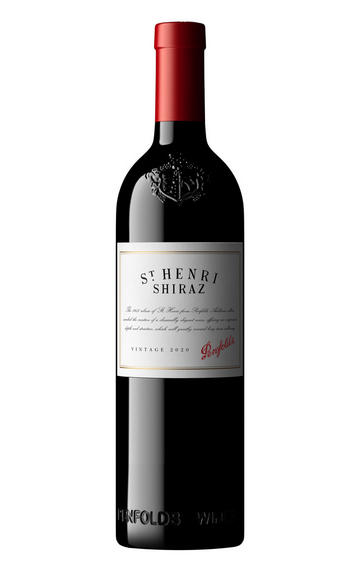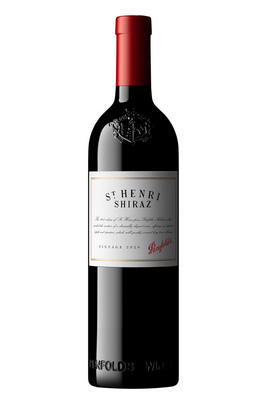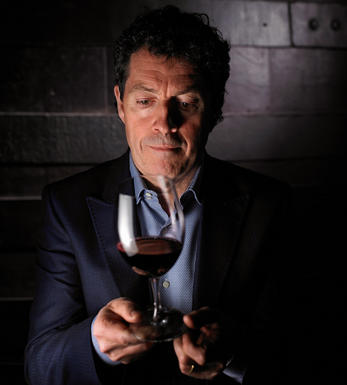
2020 Penfolds, St Henri Shiraz, Australia

Critics reviews
From vineyards in McLaren Vale, Barossa Valley and Clare Valley. South Australia experienced a second consecutive year of winter drought, followed by a cool and dry spring delaying flowering and fruit set. Root-zone moisture levels were well below average making irrigation vital. The beginning of summer was marked by a state-wide heatwave. Bunch weights and berry numbers were low and yields significantly below average across the three regions. Aged for 12 months in large, seasoned oak vats. TA 6.6 g/l, pH 3.62.
Blackish purple. Lifted, somehow glossy fruit. Salty start and very polished, welcoming ripe fruit until a slightly dry-season chewy finish. Not as hot on the end as some wines in this collection. But I would wait a little while for more complexity to form.
Drink 2025 - 2040
Jancis Robinson MW, JancisRobinson.com (July 2023)
Routinely my favorite red cuvée in the Penfolds Collection (matured in large-format seasoned French oak), there is always a freshness and suppleness to the fruit that is most elegant in the glass. Here, the 2020 St Henri Shiraz shows the warm and low-yielding season from whence it came in the splay of roasted beetroot, red fruits and meats on the mid-palate. A chunky, meaty iteration of this wine, the tannins are grippy and full in the mouth. You get aniseed and clove through the finish. 14.5% alcohol, sealed under screw cap.
Drink now to 2040
Erin Larkin, Wine Advocate (July 2023)
Dense, dank and brooding. A very warm vintage, serving an incantation of licorice strap, clove, camphor, dried nori and a spicy backdrop to a flood of dark, saturated fruits. Often the cuvee that I prefer most, however the tannins in this instance are more four-square, burlier, thick grape skin-gritty and less resolved than usual. A bit drying. The oak, classy and firm, compressing and directing.
Best after 2028
Ned Goodwin MW, Senior Editor at JamesSuckling.com (July 2023)
Always the most unique, savoury and graceful red in the Penfolds stable, beloved for the fact it does not see any new oak (just 12 months in large, seasoned vats) and thereby emphasises the unadulterated purity of South Australian Shiraz. And the dry, low-yielding 2020 vintage has delivered an already approachable St Henri whose score may well improve with further maturation (in the meantime I wait with rapt anticipation for the 2021…).
More McLaren Vale fruit joins the Barossa and Clare parcels this vintage thanks to late summer rain, and the result is a textured, mineral, fresh-fruited profile that conjures up rhubarb, cherries and wild strawberries along with seaweed, curry spices and polished leather enveloped in dusty, textured tannins.
Drink 2023 - 2050
Tina Gellie, Decanter.com (June 2023)
The 2020 Shiraz St Henri lives up to its traditional claret billing, reserved, subtle and built to last. Excellent color to begin before delivering a refined mix of coca, blackberry and black olive tapenade with a subtle dusting of old spice. It's mid-weight, firm and stylish, with more gravel and graphite flavors starting to emerge. The vintages' firm tannins are well-matched and draw out a lengthy finish. You can bank off this drinking well for a couple of decades.
Drink 2028 - 2042
Angus Hughson, Vinous.com (July 2023)
About this WINE

Penfolds
Penfolds enjoys an iconic status that few New World producers have achieved. Established in 1844 at the Magill Estate near Adelaide, it laid the foundation for fine wine production in Australia.
The winemaking team is led by the masterful Peter Gago; it has the herculean task of blending the best wines from a multitude of different plots, vineyards and regions to create a consistent and outstanding range of wines. Its flagship wine, Grange, is firmly established as one of the finest red wines in the world.
Under Gago’s stewardship, the Penfolds range has evolved over time. Winemaking has moved away from New World heat and the sort of larger-than-life style that can mask individuality; the contemporary wines instead favour fine balance and typicity for the region or grape.

Barossa Valley
Barossa Valley is the South Australia's wine industry's birthplace. Currently into its fifth generation, it dates back to 1839 when George Fife Angas’ South Australian Company purchased 28,000 acres at a £1 per acre and sold them onto landed gentry, mostly German Lutherans. The first vines were planted in 1843 in Bethany, and by the 1870s – with Europe ravaged by war and Phylloxera - Gladstone’s British government complemented its colonies with preferential duties.
Fortified wines, strong enough to survive the 20,000km journey, flooded the British market. Churchill followed, between the Wars, re-affirming Australia’s position as a leading supplier of ‘Empire wines’. After the Second World War, mass European immigration saw a move to lighter wines, as confirmed by Grange Hermitage’s creation during the 1950s. Stainless-steel vats and refrigeration improved the quality of the dry table wines on offer, with table wine consumption exceeding fortified for the first time in 1970.
Averaging 200 to 400 metres’ altitude, the region covers 6,500 hectares of mainly terra rossa loam over limestone, as well as some warmer, sandier sites – the Cambrian limestone being far more visible along the eastern boundary (the Barossa Ranges) with Eden Valley. Following a diagonal shape, Lyndoch at the southern end nearest Gulf St Vincent is the region’s coolest spot, benefiting from sea fogs, while Nuriootpa (further north) is warmer; hot northerlies can be offset by sea breezes. The region is also home to the country’s largest concentration of 100-year-old-vine Shiraz, Grenache and Mourvedre.
Barossa Valley Shiraz is one of the country’s most identifiable and famous red wine styles, produced to a high quality by the likes of Rockford, Elderton, Torbreck and Dean Hewitson. Grenache and Mourvèdre are two of the region’s hidden gems, often blended with Shiraz, yet occasionally released as single vineyard styles such as Hewitson’s ‘Old Garden’, whose vines date back to 1853. Cabernet Sauvignon is a less highly-regarded cultivar.
Wines are traditionally vinified in open concrete fermenters before being cleaned up and finished in American and French oak barrels or ‘puncheons’ of approximately 600 litres. Barossa Shiraz should be rich, spicy and suave, with hints of leather and pepper.

Syrah/Shiraz
A noble black grape variety grown particularly in the Northern Rhône where it produces the great red wines of Hermitage, Cote Rôtie and Cornas, and in Australia where it produces wines of startling depth and intensity. Reasonably low yields are a crucial factor for quality as is picking at optimum ripeness. Its heartland, Hermitage and Côte Rôtie, consists of 270 hectares of steeply terraced vineyards producing wines that brim with pepper, spices, tar and black treacle when young. After 5-10 years they become smooth and velvety with pronounced fruit characteristics of damsons, raspberries, blackcurrants and loganberries.
It is now grown extensively in the Southern Rhône where it is blended with Grenache and Mourvèdre to produce the great red wines of Châteauneuf du Pape and Gigondas amongst others. Its spiritual home in Australia is the Barossa Valley, where there are plantings dating as far back as 1860. Australian Shiraz tends to be sweeter than its Northern Rhône counterpart and the best examples are redolent of new leather, dark chocolate, liquorice, and prunes and display a blackcurrant lusciousness.
South African producers such as Eben Sadie are now producing world- class Shiraz wines that represent astonishing value for money.


Buying options
Add to wishlist
Description
The outlier of the Luxury & Icon range, with its ageing in large, old oak foudres, St Henri is always a crowd favourite for BB&R staff and customers alike. This is all about the bright, pure, spicy fruit, allowed to shine in the absence of new wood. Blackcurrants, cracked black pepper and cloves stand out now, which mellow over time. A bottle of 2010, tasted last month was just perfect. Heresy perhaps, but for pure drinking pleasure, you can keep Grange as long as you leave the St Henri for me!
Drink from 2025 onwards
Fergus Stewart, Private Client Manager, Berry Bros. & Rudd (September 2023)
wine at a glance
Delivery and quality guarantee